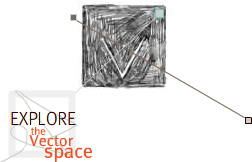Public Secrets
Design by Erik Loyer
Designer's Statement
Sharon Daniel brought up treemaps as a visual motif very early in the design process for Public Secrets. I was initially resistant to the idea—frequently things get a bit literal at that stage and I was worried that screens filled with rectangles would feel simplistic or cliché in the context of a project dealing with the prison industrial complex. As our visual explorations proceeded, however, I found myself drawn back to treemap visualizations because they embody both a utopian relationship between the individual and the state, and its opposite as we find it in the abuses endemic to our system of incarceration.
To generate a treemap, one provides the algorithm with the dimensions of a rectangle and a list of items to be laid out within it, along with a value for each item. When given this information, the algorithm grants each item a rectangle the area of which is proportional to the item's value. The algorithm also calculates the position and dimensions of each rectangle so that all them taken together exactly fill their enclosing shape. To put it another way, if I've got a box and a bunch of things to put in it, the treemap algorithm makes all those things fit in the box perfectly, while preserving their relative size relationships.
We use treemapping in Public Secrets as a metaphor rather than as a visualization as the algorithm was originally intended; the proportional relationships between our rectangles are randomly generated or in some cases, fixed. We've also developed our own typographic riff on the treemap, in the form of a routine that dynamically arranges type to fit the dimensions of a rectangle as closely as possible while retaining visual interest, readability and beauty. Both algorithms are combinations of the individual and the authoritarian, conforming exactly to the dimensions of content while organizing that content to conform exactly to the structures that enclose it.
The more I worked with these algorithms, the more I found them to be patently seductive "black boxes" in which words could be made beautiful even as they were compelled to conform to the dimensions of their containers. I was pleased to discover that with the combination of our treemap and typographic algorithms, we could put anything anywhere and it would fit. It became easy to overlook the occasional rendering glitch or phrase shrunk too small to be readable because the program itself was doing such an excellent job of solving the aesthetic problem: how do I make all this stuff fit and still look good?
Of course, "make it fit and look good" as a design rationale is hardly sufficient, but neither could we ignore the affordances our algorithms brought us in concept and aesthetics. In fact, the design process itself thus came to resonate with the broader task of reconciling the needs of the state with the rights of the individual, with all of its concomitant messiness and imperfection. Having chosen the aesthetic practicality of an all-encompassing algorithm, Sharon and I found ourselves walking the razor's edge, constantly challenged to keep the algorithm accountable to the content it contained while retaining its essential nature as an automatic process rather than as a collection of exceptions.
The final product is flawed, of course. Sometimes things still get a bit mangled or look a little strange. Many of these are problems that we chose to leave alone because the fix would either be too costly in terms of time or could break some other more critical aspect of the system. Wherever possible, however, we tried to modify the form to best serve the purpose of the content. And while people are much more than content, prisons much more than form, and metaphors ultimately unable to do justice to the magnitude of what is going on in the lives of the women who testify here, such microcosmic resonances can indeed bear witness to what must be done in response.



